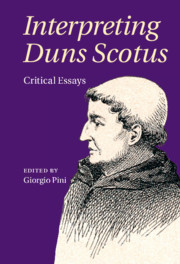Book contents
- Interpreting Duns Scotus
- Interpreting Duns Scotus
- Copyright page
- Contents
- Acknowledgments
- Notes on contributors
- Introduction
- Chapter 1 John Duns Scotus’s life in context
- Chapter 2 The modal framework of Duns Scotus’s argument for the existence of a first cause
- Chapter 3 Duns Scotus on essential order in De Primo Principio and elsewhere
- Chapter 4 Duns Scotus on how God causes the created will’s volitions
- Chapter 5 Duns Scotus on free will and human agency
- Chapter 6 Duns Scotus on the dignities of human nature
- Chapter 7 Duns Scotus on matter and form
- Chapter 8 Duns Scotus, intuitionism, and the third sense of ‘natural law’
- Chapter 9 The bounds of sense: adequacy and abstraction in the later works of Duns Scotus
- Chapter 10 Before univocity: Duns Scotus’s rejection of analogy
- Chapter 11 Analogy after Duns Scotus: the role of the analogia entis in the Scotist metaphysics at Barcelona, 1320–1330
- Bibliography
- Index
Introduction
Published online by Cambridge University Press: 23 December 2021
- Interpreting Duns Scotus
- Interpreting Duns Scotus
- Copyright page
- Contents
- Acknowledgments
- Notes on contributors
- Introduction
- Chapter 1 John Duns Scotus’s life in context
- Chapter 2 The modal framework of Duns Scotus’s argument for the existence of a first cause
- Chapter 3 Duns Scotus on essential order in De Primo Principio and elsewhere
- Chapter 4 Duns Scotus on how God causes the created will’s volitions
- Chapter 5 Duns Scotus on free will and human agency
- Chapter 6 Duns Scotus on the dignities of human nature
- Chapter 7 Duns Scotus on matter and form
- Chapter 8 Duns Scotus, intuitionism, and the third sense of ‘natural law’
- Chapter 9 The bounds of sense: adequacy and abstraction in the later works of Duns Scotus
- Chapter 10 Before univocity: Duns Scotus’s rejection of analogy
- Chapter 11 Analogy after Duns Scotus: the role of the analogia entis in the Scotist metaphysics at Barcelona, 1320–1330
- Bibliography
- Index
Summary
Since their first formulation, many of John Duns Scotus’s views have attracted the attention of philosophers and theologians alike. Responses have ranged from admiration to opprobrium, including (perhaps most memorably) ridicule: in the sixteenth century, Duns Scotus gained the dubious distinction of entering the English language as a common noun—through the word ‘dunce’. In the relatively tolerant and sedate environment of contemporary academia, a mention of his name might still be met with a smirk, often on account of his alleged obscurity, or even provoke an occasional outburst of hostility, especially from those who are partial to interpreting the history of philosophy as a fight between abstractions (realism versus nominalism, voluntarism versus intellectualism, transcendence versus immanence, the Secular versus the Sacred, and so forth). For mysterious reasons—probably connected to the alleged opposition between two of those abstractions, Thomism and Scotism—it is not rare to see the name of Duns Scotus associated with some vague and ghastly philosophical catastrophe.1 It is high time for Duns Scotus to be considered sine ira et studio. It is also high time for his thought to be better known, and not just among the specialists of medieval philosophy.
- Type
- Chapter
- Information
- Interpreting Duns ScotusCritical Essays, pp. 1 - 7Publisher: Cambridge University PressPrint publication year: 2022

